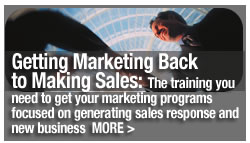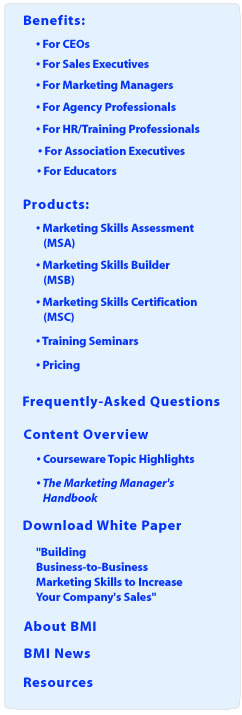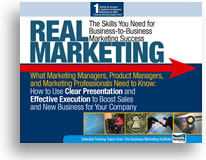



 |
 |
 |
 |

Tuesday Marketing Notes (Number 112—February 19th, 2007)
MAKE SURE YOU CONTINUE TO RECEIVE EACH ISSUE OF TUESDAY MARKETING NOTES—CLICK HERE TO RENEW YOUR FREE SUBSCRIPTION
(NOTE: If you’ve already signed up previously at this link, no need to do so again)
The Next New Big Thing (Part 1)
by Rick Kean
Recent B2B budget allocation studies show a continuing trend of declining budgets for print communications in favor of increases in allocations for online communications, even as recessionary talk intensifies. Is this a shift of paradigm proportions, (which Webster defines as “one that serves as a pattern or model”) or is it just survey respondents hedging their bets? The next new big thing or the same old thing?
Let’s see. Here are the things we know for sure . . .
1: Buyers Still Read
They read magazines, brochures, direct mail, e-mail, white papers, e-books and the information you’ve provided on your Web site. They’re still looking for information. The business buyer wants to buy, literally has to buy. Nothing’s changed. All business enterprises need to acquire other products to address a specific need or solve a problem.
Because the business buyer is looking to buy, business-to-business communications can and should be direct and to the point. Because business products are more complex, the communications job is to clarify and simplify.
The challenge is to get the interest of readers who are not experts about your company or its products. Too many companies have the wrong idea about how this works. Communications brings the company to its audience, customers and potential customers, and that audience wants information on matters of personal gain or benefit to their companies. The product or service itself is just the device that fills certain expectations. For the reader, the most important question always is: “What’s in this for me?”
2: Readable Stuff Gets More Attention
Whether or not your communications gets read and how much of it gets read depends on a series of quick decisions by a busy person who is performing one of their job functions, and will start reading only what promises to be profitable—and will continue reading only as long as the message sustains their interest. Anything that bores, or confuses, or distracts them, or requires more reading time than they are willing to spend—dooms the communications to failure.
This communication should be clean, simple, and inviting. It should talk in a person-to-person manner and state its case in a friendly tone. Copy that is set in small type or squeezed into corners or printed over illustrations makes it difficult to read. Lack of specificity in product design or performance characteristics will not be acceptable to readers who want more than generalities or unsubstantiated claims.
Make headlines simple, unbroken thoughts and set them in upper and lower case (not all caps). Body copy should be at least 9 point. Reverse type, especially in body copy, will probably reduce readership by 50%. People are used to reading newspapers and magazines with columns no more than 40 characters wide, (an alphabet and a half). Seven or 8 lines is plenty for any one paragraph. Give each paragraph a single idea to develop. Use familiar typefaces, preferably those with serifs, and use subheads. Sadly, typography has become a lost art and anyone with a computer sees themselves as a designer and typesetter. People read what is easiest and most familiar to them. Make your communications easy to read.
3: Frequency Works
The Ebbinghaus Curve is a 100-year-old theory developed by Herman Ebbinghaus, a pioneer in scientific memory research. It tells us that readers forget 50% of what they’ve read after 24 hours, 90% after a week. Repetition is the key to learning. Doing something over and over, seeing something over and over, hearing something over and over—that’s what fixes it firmly in your mind. That’s also the key to effective communications.
To get the maximum return on what you invest in communications, you need to keep it going. Starting and stopping is a costly mistake, because it keeps reversing the awareness-building process. It’s far less costly for you to maintain the awareness you’ve built up than to regain it once you’ve let it go to waste.
For example, a business-to-business ad must run at least 4 or 5 times before you could expect to see any results. Yet 80% of all companies run fewer than five ads in a year. Worse, nearly half run fewer than two. Running an ad once or twice is a waste of money. After all, if it takes five personal calls to close a sale, an ad or two can’t be expected to accomplish much.
When times are tough, frequency is more important than reach. Instead of waiting for business to “return to normal,” you should be cashing in on the opportunity your over cautious competitors have created for you. There are 40 years' worth of studies that prove that “recessions” are the time your share of market can change radically. The fact that your competitors have or will pull back can make your marketing budgets look and act even bigger. Woody Allen was right, 80% of success is just showing up.
4: More Communications are Ignored than are Noticed
The average reader spends 7 seconds with a message (more than enough time to screw up an opportunity to communicate with this reader). In those 7 seconds a reader can read your headline, glance at the photo or illustration and make a quick judgment about whether your offering has anything of value. B2B prospects aren’t buying for ego, status or any other typical consumer motives. Business-to-business communications has to give reasons-why—some sort of benefit to the reader.
The business buyer is more sophisticated about what you’re trying to sell and typically has years of training or experience. And, he or she has a high interest level and an understanding of the product or at least of the problem the product is designed to solve. Consequently, they won’t respond well to oversimplification or generalities. But they will read a lot of copy if it’s interesting, relevant and they think it can help them. Think of what you do as communication between two parties who are looking for each other. If your communication doesn’t contain any information or benefit for the other party, it won’t last more than 7 seconds.
5: Good Products Can Die from Lack of Support
Product differentiation has left the building. Quality, price, delivery, all of the complex technology, the product features that won the day for companies for most of their business lives are only tickets to the game today. Thanks (or no thanks) to the growth in global markets and smarter, more aggressive marketer, you are surrounded by a whole new group of competitors pretty much capable of doing what you do. In such a parity marketplace, the only differentiating feature that a company can bring to customers is what those customers believe about a company, its products and/or services and their relationship with it.
6: Bean Counters Trust Tangible Things
Companies continually underfund their marketing communications or sales support because the people in charge of approving budgets either don’t understand it, or they’re suspicious of it. No doubt that’s because so many people in top management came from the supply side of the business. They’re from a different gene pool than marketing folks. Those people tend to trust things they can see, like more salespeople. They believe that adding reps builds sales incrementally, when you and I know that in reality it’s enhanced sales productivity and reduced selling costs
Actually, research tells us that in the last 10 years face-to-face selling in business markets has dropped from 4 hours per day to fewer than 2, and voice mail, e-mail and the Web guarantee that’s a trend that will only continue. Yet you rarely hear of downsizing in the sales organization. That’s because most companies selling to other companies are sales-driven. Sales success is measured in tangibles—units sold, customers won, terms that CEOs and CFOs relate to and understand.
As marketers, we’re too theoretical. We spent too many years talking about awareness and “advertising” (a word that too often was more a matter of faith than fact). The difficulty in measuring what we were doing is the underlying reason why marketing has lost much of its esteem among those in management today, witnessed by the reduction in our numbers.
In fact, organizations frequently define marketing in terms of traditional communications methods. Way too many marketing teams focus on the awareness and maybe the consideration phases of marketing and have nothing going on for the preference and purchase phases of the marketing process. That situation is driven by corporate organizations that have allowed marketing to move further away from the sales function. As marketing becomes less about top line revenue and more about “brand” or “awareness,” linkage to the sales teams, and to their need to drive revenue, breaks down. And then sales, left without any real support on the preference and purchase phases, creates its own marketing services organization, often referred to as field sales.
If we want to elevate our status from corporate bullhorn to driver of the company’s go-to-market strategy and tactics, we need to focus on two main goals: 1.) Feeding the sales machine today and 2.) Driving the strategic push to define “what’s next.” In other words, we need to be doers, not dreamers.
Next week we’ll examine more of these things we as marketers know for sure . . .
Rick Kean (rkean@businessmarketinginstitute.com) is the Managing Director of the Business Marketing Institute
Real Marketing: The Skills You Need for Business-to-Business Marketing Success, a 47-page overview of content covered by the BMI MSA/B/C Training and Certification System




Login![]() Home
Home![]() Free Demo
Free Demo![]() Free Newsletter
Free Newsletter![]() Order Now
Order Now![]() Contact Us
Contact Us
Copyright 2005-2008 Business Marketing Institute, LLC

